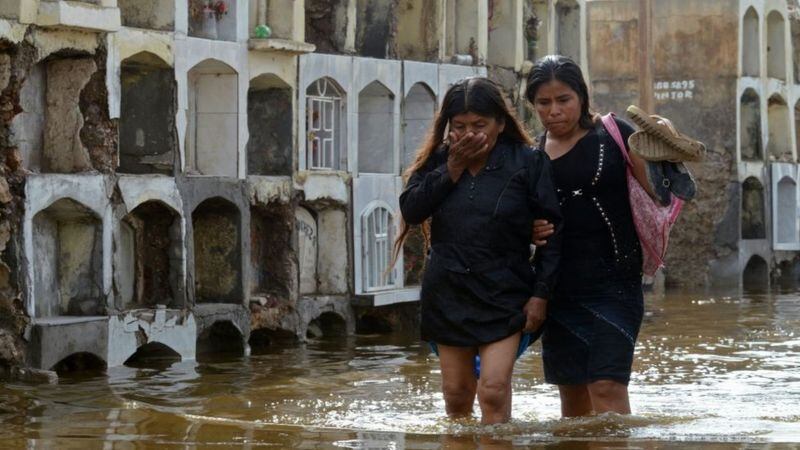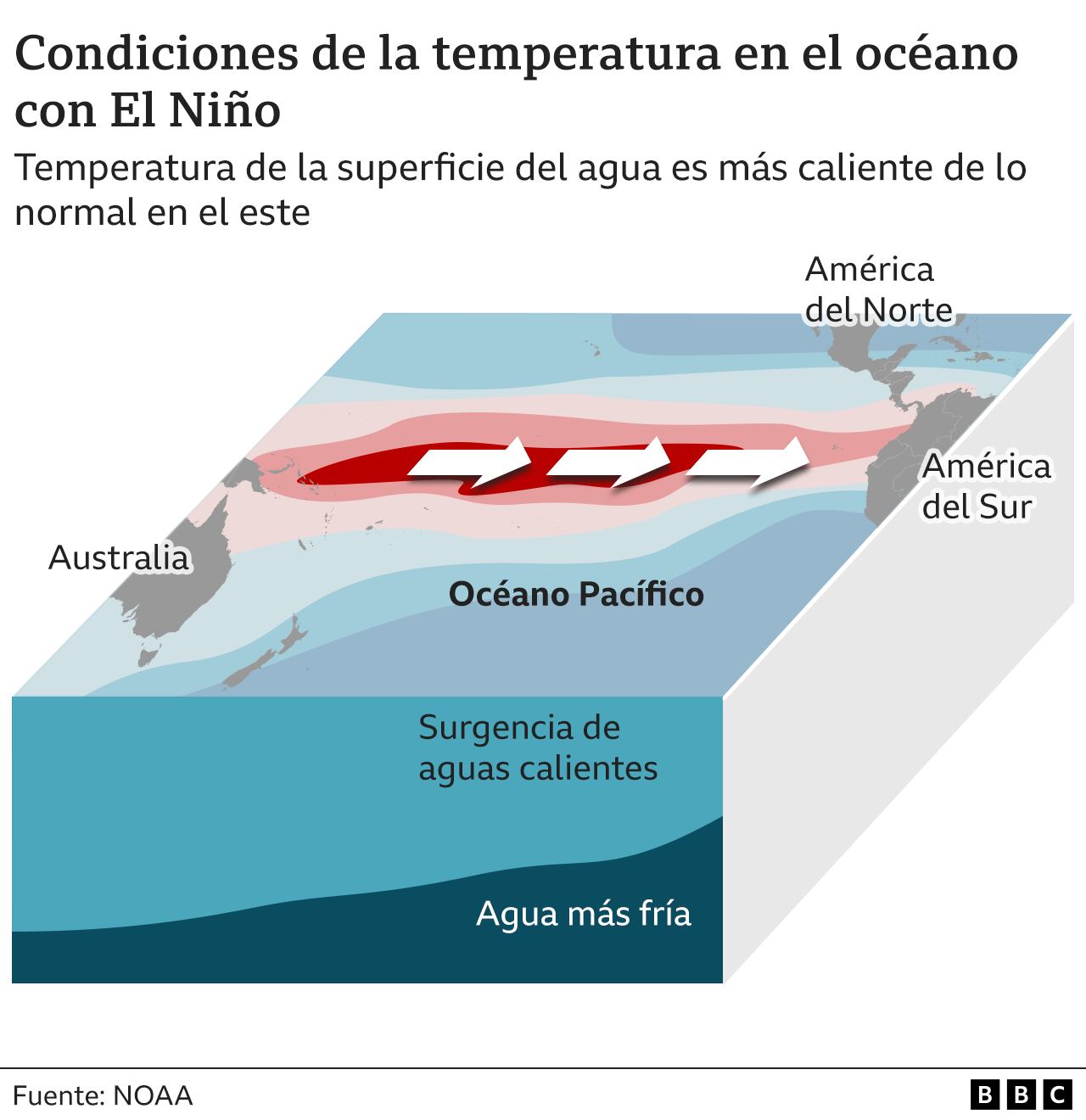A group of US scientists confirmed this Thursday what they warned for months: the El Niño phenomenon It already affects the planet.
According to experts, this climatic event that takes place in the Pacific Ocean will increase global temperatureswhich in recent years have been growing as a result of climate change.
LOOK: A powerful El Niño phenomenon is forming: The “inexplicable” warming of the oceans that alarms scientists
Their arrival could push the world past the key 1.5C warming milestone, they argue. El Niño is expected to last until spring 2024and make next year the hottest in history.
“It’s rising now, there have been signs in our forecasts for several months, but it really looks like it’s going to peak at the end of this year in terms of intensity,” said Adam Scaife, head of long-range forecasting at the UK Met Office. United.
“A new record for global temperature next year is definitely possible. It depends on how big an El Niño turns out to be. A full-scale El Niño by the end of this year gives a high probability that we will have a new global temperature record in 2024″, he added.
This natural phenomenon is the most powerful fluctuation in the weather system anywhere on Earth.
LOOK: Global warming will exceed the crucial limit of 1.5 ºC by 2027: “It is the first time in history that we are so close”
The last time El Niño formed was in 2016 and its effects were felt around the world.
It contributed to record rising temperatures, the loss of tropical forests, coral bleaching, the generation of forest fires and polar melting.
In this note, which we did in April of this year but we have updated regarding the arrival of this event, we offer you more details about its possible consequences.
extreme events
El Niño is a natural climatic phenomenon -not caused by man- of which there are references, at least, since the end of the 19th century.
“El Niño is basically a change in the strength and direction of the trade winds that blow from east to west in the Pacific Ocean.which causes the warm water found in the western part of the Pacific Ocean to move towards the central and eastern Pacific region,” explains Ángel Adames Corraliza, professor of Atmospheric Sciences at the University of Wisconsin, to BBC Mundo.
It is not an innocuous change.
The expert points out that the movement of these warm waters favors a significant increase in ocean temperatures in the central and eastern Pacific.
“High ocean temperatures are more conducive to heavy downpours and flooding. And that has consequences for the hydrological cycle on the west coast of South America, especially in Peru and Ecuador. There are even some direct effects on the atmospheric circulation that cause changes in the weather conditions and in the climate in general both in North and South America and in other parts of the world as well”, he points out.
Adames assures that this causes concern, especially because a strong El Niño – like the one being forecast for this year – is often associated with extreme weather events.
“We’re talking about the possibility of seeing extreme weather events that don’t tend to occur commonly, because El Niño basically changes the weather. So we see things that are unusual in different regions. That is a reason to worry,” she notes.
This meteorological phenomenon causes, for example, that in regions that are usually very rainy, such as the north of Australia, droughts and fires occur; while in places like the west coast of South America, whose climate is dry and which is known for its deserts, heavy rains occur.
“The first impact that is seen is warming off the coast of Peru. This year, if the record is not broken, it is almost done. It’s extremely warm and we’ve seen downpours with an intensity and strength that you don’t commonly see, except when you have those very high temperatures, causing tremendous floods, landslides and loss of life and material resourcessays Adames.
He explains that the development of El Niño, especially if ocean temperatures continue to rise, often leads to a more active hurricane season in the eastern and central Pacific.
“During El Niño years there is an increased risk of hurricanes for the west coast of Mexico and for Hawaii. We frequently see hurricanes or typhoons that cross the ocean and more intense hurricanes occur in the southernmost region of the western Pacific Ocean. In contrast, hurricane activity in the Atlantic Ocean decreases,” he notes.
Adames indicates that, although it is still something that is being studied, there are indications that El Niño tends to cause drought in the Caribbean during the boreal summeraffecting places like Cuba, the Dominican Republic and Puerto Rico.

At times, this drought can spread to Central America -from Panama to Honduras, in particular-, as well as cause heat waves in the Amazon region.
“In general, the impacts tend to be more of heat and drought for Latin America, but the largest effects tend to occur on the western slope of the Andes and the mountains that predominate in Latin America. So we are talking about Lima and all the big cities that are in that coastal region on the Pacific side of South America that tend to get very big impacts in terms of downpours and heat,” Adames points out.
global warming reinforcement
Although El Niño has a natural origin unrelated to global warming caused by human activities, it can contribute to the increase in temperatures on the planet.

This climatic phenomenon is characterized by a release of heat from the Pacific Ocean into the atmosphere, through which it is distributed.
“El Niño years tend to be warmer than normal, so if we have a possibly record-breaking El Niño this year, or it’s extremely strong, we’re talking about a significant warming of the atmosphere that will be adding to the global warming caused by humanswarns Adames.
“The second half of this year – and more likely next year – will be an extremely hot period with many heat waves because we are talking about El Niño warming in addition to human-caused warming. So possibly 2024 or the end of this year, it will be one of the warmest we have experienced on record”, he added.
Source: Elcomercio
I am Jack Morton and I work in 24 News Recorder. I mostly cover world news and I have also authored 24 news recorder. I find this work highly interesting and it allows me to keep up with current events happening around the world.

:quality(75)/cloudfront-us-east-1.images.arcpublishing.com/elcomercio/FVVJVN24QZCCVIADGY3W2W2NHU.jpg)

:quality(75)/cloudfront-us-east-1.images.arcpublishing.com/elcomercio/GQ5MXUGY25EE5K6V6SGXA6VJSE.jpg)
:quality(75)/cloudfront-us-east-1.images.arcpublishing.com/elcomercio/E3W4JKQJORCMDPGVQ7GACVGONE.jpg)
:quality(75)/cloudfront-us-east-1.images.arcpublishing.com/elcomercio/OWV66FFFTJHANPDVSZJKZABWGY.jpg)
